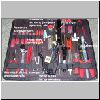|
Patience and Plugs. There you have it, the two P's of Geek power. Be Patient and always remember, only Plug in the plugs that match. That last bit is the real key, and all kidding aside, if you remember that one simple fact when assembling a computer even you can build the Holy Grail of computers. Actually it isn't all that surprising if you think about it. The folks who make computers for a living need inexpensive labor. There is no reason why a computer should be difficult to build as long as you make the bits easy to assemble correctly, and that is exactly what hardware manufacturers have done.
Let There Be Parts
We won't presume to tell you in this article what kind of computer to build. You know what you want to do and what your budget will allow, so take your time and work out the best compromise of those two fundamentally conflicting factors. Depending on where you are in the world, you may not be able to walk in to a local discount computer parts store and choose the bits you need right off the shelf. Too bad. While mail (or Net) ordering parts is convenient, it has the singular disadvantage of not being able to ask questions of the resident local computer-shop-Geek. These Geeks can often help you sort out problems with your choices in hardware before you make your purchase. However, for the purposes of this article we will assume you have the parts you need to build a working computer.
You will need a clean, quiet space about the size of your kitchen table with an
electrical outlet nearby where you can work without interruption. The absolute
minimum of tools you need are a non-magnetic Phillips screwdriver and perhaps a
small pair of needle-nose pliers with insulated grips.  If you plan on building computers from scratch repeatedly, doing this
professionally, plan on repairing older computers, or are a tad clumsy, you
might need a few more tools such as depicted here. Your hands must be clean and
dry and you must remember the first commandment of working on electrical
appliances: Thou Shalt Not Electrocute Thyself.
If you plan on building computers from scratch repeatedly, doing this
professionally, plan on repairing older computers, or are a tad clumsy, you
might need a few more tools such as depicted here. Your hands must be clean and
dry and you must remember the first commandment of working on electrical
appliances: Thou Shalt Not Electrocute Thyself.
The second commandment is almost as important: Thou Shalt Ground Thyself On The
Chassis Before Touching Computer Parts. As you know, static electricity will
destroy expensive computer bits in the blink of an eye. Each time you reach out
to touch a computer part you should first ground yourself by touching the
computer chassis before doing so. This is why it is important to work with the
computer plugged in and grounded. The real trick to satisfying both the First
and Second Commandments Of Computing is to plug the computer into a surge
protector with the power turned off. This maintains the ground but reduces or
eliminates the chance of shocking yourself.
The third commandment is: Thou shalt not apply excessive force. Any time you
insert a card or chip into a slot, be gentle. Push gently, rock the part back
and forth a bit if necessary. If it just doesn't want to go in, it's probably
either in the wrong slot or inserted the wrong way. Sometimes you have to push
firmly, but using too much force can break things, so be careful.
Page 1: Building your PC
Page 2: Starting to build your PC - let
the party begin
Page 3: Assembly - The Motherboard
Page
4: Installing Drives
|